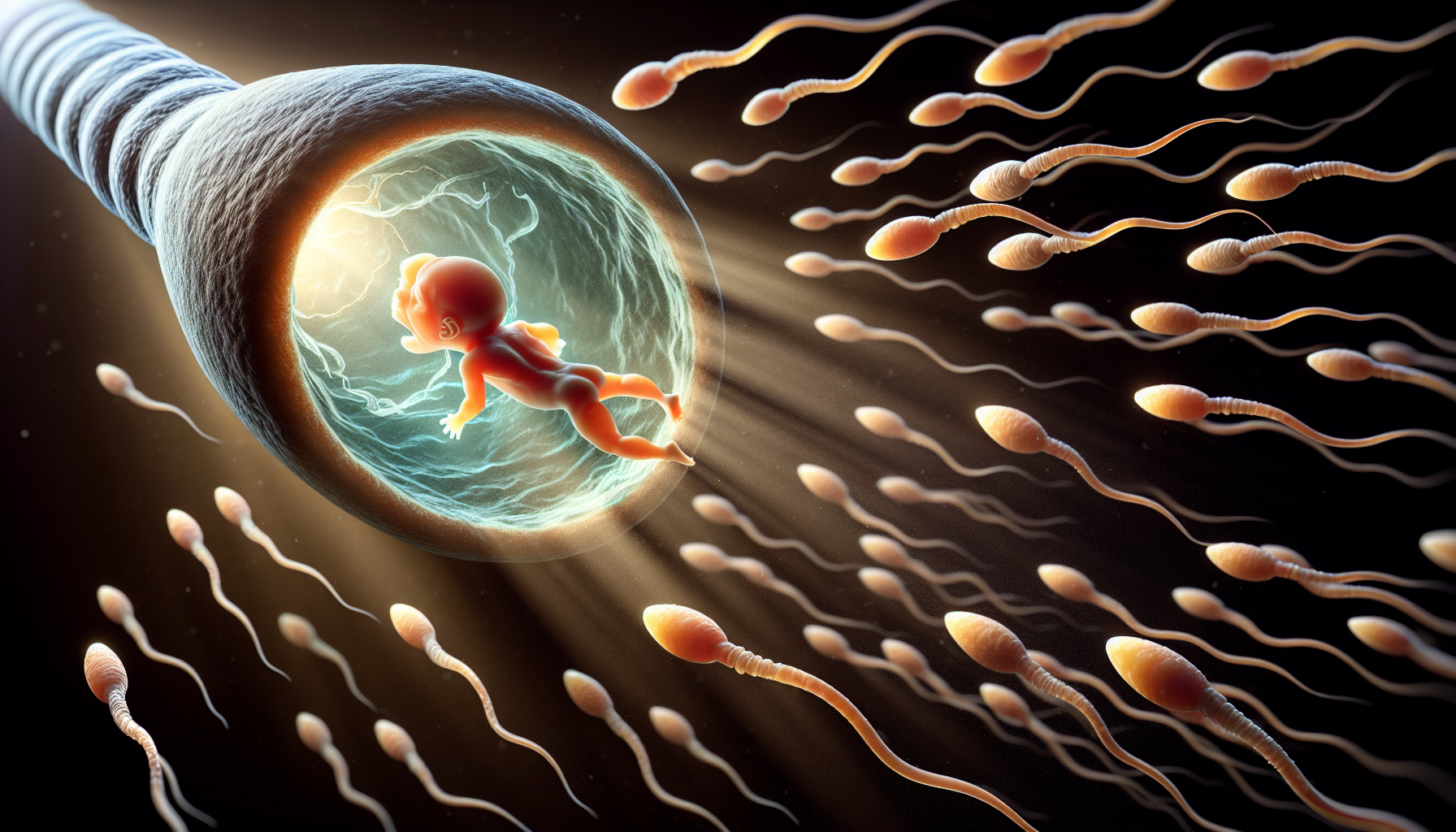In the vast tapestry of human history, there are few concepts as intriguing and perplexing as that of the homunculus—a tiny human purported to reside within a sperm cell. This notion, captivating in its audacity, has enthralled scientists, philosophers, and alchemists for centuries, prompting debates that stretch across the realms of biology, mysticism, and the very essence of life itself. But what if we told you that this age-old enigma holds secrets that transcend mere myth and superstition, and might even shed light on the intricacies of human development and consciousness? 🌌
The story of the homunculus is as much a journey through the corridors of human curiosity as it is a tale of scientific evolution. Originating in the annals of ancient alchemy and later seeping into the burgeoning fields of early modern biology, the idea of the homunculus has served as both a symbol of mankind’s quest for understanding and a testament to the power of imagination. It represents a period when the lines between science and magic blurred, and when the mysteries of life were not merely questions to be answered, but puzzles to be pondered and explored. This article embarks on a quest to unlock these mysteries, exploring the historical roots, scientific debates, and cultural ramifications of this fascinating concept.
As we delve deeper, we’ll uncover the origins of the homunculus in the esoteric traditions of the Middle Ages and its subsequent evolution through the Renaissance—a time when thinkers like Paracelsus began to formalize the idea, combining elements of mysticism and early scientific inquiry. From there, the narrative takes us to the Age of Enlightenment, where the homunculus was both challenged and enriched by emerging scientific discoveries, leading to a broader understanding of human reproduction and embryonic development. This journey through time not only reveals the transformation of a single concept but also reflects the broader evolution of human thought and the shifting paradigms of scientific inquiry.
But the homunculus is not just a relic of the past; it continues to resonate in modern discourse, finding new life in discussions about genetic engineering, artificial intelligence, and the nature of consciousness. As we navigate these contemporary waters, we’ll explore how the symbolic legacy of the homunculus informs our current understanding of identity and the ethical implications of creating life in a lab. From CRISPR technology to debates about artificial life, the homunculus serves as a lens through which we can examine the profound questions of what it means to be human in an age of technological wonder and moral complexity.
Join us on this captivating exploration as we unravel the layers of mystery surrounding the homunculus. We’ll piece together historical anecdotes, scientific breakthroughs, and philosophical musings to paint a comprehensive picture of a concept that, despite its diminutive size, looms large in the annals of human thought. Whether you’re a history buff, a science enthusiast, or someone captivated by the mysteries of life, this journey promises to enlighten and engage, providing a fresh perspective on a timeless enigma. Let’s unlock the secrets of the homunculus together! 🧬
The Historical Context of the Homunculus Theory
The concept of the homunculus, a miniature human believed to reside within sperm cells, originates from pre-modern science and philosophy. Historically, the idea has intrigued and puzzled scholars, often representing the intersection between mysticism and scientific exploration. This theory was particularly prominent during the medieval period, fueled by the alchemical pursuits of the time.
In the 16th and 17th centuries, alchemists and early scientists like Paracelsus entertained the notion that humans could be artificially created through specific processes, a belief rooted in the broader quest to unlock the secrets of life itself. This period was characterized by a fascinating blend of science, religion, and magic, which often blurred the lines between fantasy and reality. Paracelsus, a Swiss physician and alchemist, is frequently credited with popularizing the idea of the homunculus. He proposed that it could be created through the alchemical mixing of various substances, including human semen, in a sealed vessel. This process, though never proven, was considered a legitimate scientific inquiry at the time.
The fascination with the homunculus was not limited to Europe. Various cultures around the world have explored similar themes, reflecting a universal curiosity about human origin and the potential for life creation. The homunculus served as a symbol of these ancient explorations, representing humanity’s desire to control and replicate the mysteries of life. In contemporary times, the homunculus theory is often revisited as a historical curiosity, highlighting the evolution of scientific understanding and the enduring allure of life’s enigmas.
Alchemical Roots
Alchemy, the precursor to modern chemistry, played a crucial role in the development and propagation of the homunculus theory. Practitioners believed that through the transformation of base materials, one could unlock profound secrets of nature, including the creation of life. This pursuit often involved elaborate rituals and experiments, combining scientific inquiry with spiritual and mystical elements. Alchemists were the scientists of their time, pushing the boundaries of known knowledge and exploring realms that modern science would later demystify.
The homunculus concept fit neatly within the alchemical worldview, where transformation and transmutation were central themes. The idea that a fully formed miniature human could exist within a sperm cell or be created through alchemical processes appealed to the notion that life itself could be manipulated and harnessed through human intervention. While these ideas might seem fantastical today, they were grounded in the sincere efforts of alchemists to understand and harness the forces of nature.
Despite the lack of empirical evidence, the homunculus theory persisted in various forms throughout history, often resurfacing in discussions about the limits of human knowledge and the potential for scientific advancement. As modern science progressed, the metaphorical and philosophical implications of the homunculus continued to inspire thinkers and artists, contributing to its enduring legacy in cultural and intellectual history.
The Scientific Perspective on the Homunculus
As science advanced, the homunculus theory gradually fell out of favor, replaced by more accurate and empirically grounded understandings of human reproduction and embryology. The development of the microscope in the 17th century allowed scientists to observe sperm cells directly, debunking the notion that they contained fully formed miniature humans. This marked a significant turning point in the scientific study of reproduction, paving the way for modern genetics and developmental biology.
The work of early microscopists like Antonie van Leeuwenhoek and Jan Swammerdam provided crucial insights into the nature of sperm and eggs, laying the groundwork for our current understanding of conception and development. These pioneers used their observations to challenge prevailing misconceptions, emphasizing the complexity and intricacy of the reproductive process. The transition from speculative theories like the homunculus to empirically supported models highlights the evolving nature of scientific inquiry and the ongoing quest to understand life’s origins.
Today, the homunculus is often referenced in discussions about the history of science, serving as a cautionary tale about the limitations of speculative thinking and the importance of evidence-based research. However, it also underscores the human desire to explore and understand the mysteries of existence, a drive that continues to propel scientific discovery forward.
Modern Interpretations
In contemporary discourse, the homunculus has taken on new meanings, often used metaphorically to explore the relationship between mind and body or the intricacies of consciousness. In neuroscience, for example, the term “homunculus” is used to describe the distorted human figure that represents the relative sensory space our body parts occupy on the cerebral cortex, reflecting the complex ways our brains process sensory information.
This modern interpretation of the homunculus illustrates how historical ideas can be reimagined and repurposed to advance scientific understanding. It also highlights the importance of revisiting past concepts with a critical eye, recognizing their limitations while appreciating their contributions to ongoing intellectual exploration.
To learn more about the scientific perspective on the homunculus and its modern interpretations, watch this insightful video: The Neuroscience of the Homunculus – BrainCraft. 🎥
Homunculus in Popular Culture
The enduring allure of the homunculus concept is evident in its widespread influence on popular culture, where it has been reimagined and adapted in various forms. From literature and art to film and video games, the homunculus continues to captivate audiences, serving as a symbol of humanity’s fascination with creation and the mysteries of life.
In literature, the homunculus has appeared in numerous works, often serving as a metaphor for human ambition, hubris, and the ethical dilemmas associated with scientific advancement. Mary Shelley’s “Frankenstein” is a classic example, exploring themes of creation and responsibility through the lens of a scientist who plays god. Similarly, Goethe’s “Faust” features a homunculus character, symbolizing the quest for knowledge and the potential consequences of overreaching human ambition.
In the realm of visual arts, the homunculus has inspired a range of artistic expressions, from surrealist paintings to modern installations. These works often explore the tension between science and mysticism, highlighting the dual nature of human curiosity and the complex relationship between creator and creation.
Film and Video Games
In film and video games, the homunculus often serves as a compelling narrative device, allowing creators to explore themes of creation, identity, and transformation. Movies like “Fullmetal Alchemist,” based on the popular manga and anime series, incorporate the homunculus as central characters, exploring the moral and existential questions surrounding artificial life and the boundaries of human capability.
Video games, too, have embraced the homunculus concept, using it to enrich storytelling and gameplay. Titles like “The Witcher” and “Castlevania” feature homunculi as mythical creatures or alchemical experiments, challenging players to navigate complex moral landscapes and confront the ethical implications of creation and power.
For a deeper dive into the depiction of homunculi in popular culture, check out this engaging discussion: Homunculus in Pop Culture – Nerdwriter1.
The Ethical and Philosophical Implications
The homunculus concept raises important ethical and philosophical questions, particularly concerning the nature of life, creation, and human responsibility. These themes resonate deeply with contemporary debates surrounding genetic engineering, artificial intelligence, and biotechnology, where the boundaries of human capability continue to expand.
The idea of creating life artificially, as suggested by the homunculus theory, invites scrutiny and reflection on the ethical implications of such pursuits. It challenges us to consider the responsibilities that come with creation and the potential consequences of manipulating the fundamental aspects of life. These questions are particularly relevant in today’s world, where scientific advancements offer unprecedented opportunities and challenges.
Philosophically, the homunculus prompts us to reflect on the nature of consciousness, identity, and the human experience. It encourages a deeper exploration of what it means to be human and the ethical considerations that arise when technology and science intersect with fundamental questions of existence.
The Role of Science and Ethics
In navigating the ethical landscape of modern science, the homunculus serves as a reminder of the need for thoughtful consideration and responsible action. As we continue to push the boundaries of what is possible, it is crucial to engage with these complex questions, balancing innovation with ethical responsibility.
The homunculus theory, while no longer scientifically valid, remains a valuable tool for exploring these issues, offering insights into the ongoing dialogue between science, ethics, and philosophy. It challenges us to consider the broader implications of our actions and the role we play in shaping the future of life on our planet.
For those interested in exploring these ethical considerations further, consult the table below, which compares historical and modern perspectives on life creation:
| Aspect | Historical Perspective | Modern Perspective |
|---|---|---|
| Creation | Alchemical and mystical processes | Biotechnology and genetic engineering |
| Ethics | Rooted in religious and philosophical beliefs | Guided by scientific and ethical frameworks |
| Responsibility | Limited understanding of consequences | Informed by research and policy |
As we navigate the future, the lessons of the homunculus theory remind us of the importance of grounding scientific pursuits in ethical considerations, ensuring that our quest for knowledge remains aligned with the values and responsibilities that define our shared humanity.

Conclusion
Unlocking the Mystery: The Homunculus – A Tiny Human Inside Sperm Revealed!
In this enlightening exploration of the intriguing and somewhat mystical concept of the homunculus, we’ve ventured into the historical, scientific, and cultural dimensions of an idea that captivated human imagination for centuries. By revisiting the notion that there once existed a tiny, fully-formed human within sperm, we have delved into a fascinating chapter of early biological science that influenced the way generations perceived human reproduction and development.
At the outset, we embarked on a journey through the annals of scientific history, examining how the homunculus theory, rooted in preformationism, took hold in the 17th and 18th centuries. We discussed how this theory was heavily influenced by the limited scientific understanding and technological capabilities of the time. The concept of a homunculus—a miniature human contained within a sperm cell—captured the imagination of early scientists and philosophers. This idea was propagated by notable figures such as Nicolaas Hartsoeker, who visualized these tiny beings through the lenses of the primitive microscopes available in his era.
As we progressed, we acknowledged the role of cultural and religious beliefs in nurturing the homunculus theory. During this period, scientific inquiry was deeply intertwined with philosophical and theological doctrines. The belief in preformationism resonated with certain religious views about the sanctity and predetermined nature of life, further embedding the homunculus idea in societal consciousness.
We then transitioned to the transformative period of the Enlightenment, a time when scientific rigor and empirical evidence began to challenge and eventually dismantle preformationist ideas. The advancements in microscopy and biological research led to the discovery of cellular development and the realization that life arises from a complex process of cellular division and differentiation, not from fully-formed miniatures. This shift from preformationism to epigenesis marked a pivotal moment in the history of biology, setting the stage for modern embryology and genetics.
In our discussion, we also highlighted the lasting cultural impact of the homunculus concept. Despite being scientifically debunked, the homunculus has persisted in popular culture, literature, and even psychological theory, illustrating the enduring power of early scientific ideas to shape human thought and creativity. From the works of alchemists to contemporary media, the homunculus continues to inspire and provoke curiosity.
Moreover, we explored the ethical implications and philosophical questions that arise from early theories like the homunculus. These discussions prompt us to reflect on how scientific paradigms influence our understanding of life and human identity. They encourage us to consider the responsibilities that come with scientific discovery and the importance of maintaining a balance between curiosity and ethical consideration.
Revisiting the story of the homunculus underscores the importance of scientific inquiry and the evolution of knowledge. It reminds us that while science is a powerful tool for understanding the world, it is also an evolving narrative, continually refined and reshaped by new discoveries and insights. The tale of the homunculus serves as a testament to the importance of skepticism, critical thinking, and the willingness to question established beliefs in the pursuit of truth.
As we conclude this exploration, it is crucial to recognize the value of revisiting historical scientific theories. They provide us with perspective on how far we have come and offer valuable lessons for the future. By understanding the past, we are better equipped to navigate the complexities of modern science and to appreciate the intricate beauty of human development and life.
We encourage you, dear reader, to reflect on the journey through the mysterious world of the homunculus. Share your thoughts, engage in discussions, and consider how these historical insights might inspire your own exploration of scientific ideas. Whether you’re a student, a professional, or simply a curious mind, there’s always something new to learn and discover.
Feel free to share this article with friends and colleagues who might be intrigued by the story of the homunculus. Engage in conversations that challenge assumptions and foster a deeper understanding of the intricate processes that define life. By sharing knowledge, we continue to unlock mysteries and broaden the horizons of human understanding.
For those eager to explore further, here are some valuable resources and active links that delve deeper into the history and science behind the homunculus concept:
1. The History of Preformationism
2. Embryology and Developmental Biology
3. Cultural Impact of Scientific Theories
Remember, the quest for knowledge is an endless journey, and each discovery, no matter how small, brings us closer to unlocking the mysteries of our world. Keep exploring, keep questioning, and let the spirit of curiosity guide you in all your endeavors. 🌟
Thank you for joining us on this fascinating journey through history and science. Until next time, stay curious and inspired!
Toni Santos is a visual storyteller and conceptual archivist whose work explores the curious, often poetic ruins of pseudoscience and obsolete theories. With a reverence for forgotten frameworks and fantastical logic, Toni illuminates the imaginative spaces where science once drifted into myth, speculation, and symbolic belief.
His creative path is rooted in a fascination with the fringe — from phrenology maps to ether diagrams, hollow earth charts to animal magnetism illustrations. Each visual Toni creates or curates is an invitation to reexamine the strange beauty of discarded knowledge — not as failure, but as cultural reflection, as art born from our eternal desire to explain the unexplainable.
Blending visual design with historical inquiry, Toni gives new life to lost diagrams, metaphysical charts, and antique engravings that once shaped worldviews. His work occupies the liminal zone between fact and fiction, where obsolete models still pulse with philosophical resonance and forgotten charm.
As the mind behind Vizovex, Toni shares illustrated essays, curated collections, and visual reinterpretations that invite others to explore the aesthetic and symbolic value of outdated theories. His goal is not to validate, but to remember — to view these speculative systems as relics of human creativity, vulnerability, and yearning.
His work is a tribute to:
The elegance of error in the evolution of knowledge
The symbolic artistry of discarded explanations
The blurred lines between belief, observation, and imagination
Whether you’re a collector of curious ideas, a lover of forgotten diagrams, or someone drawn to the strange scaffolding of old worldviews, Toni opens a portal to a time when the universe was still full of ghosts, humors, and cosmic fluids — one chart, one symbol, one discredited wonder at a time.





